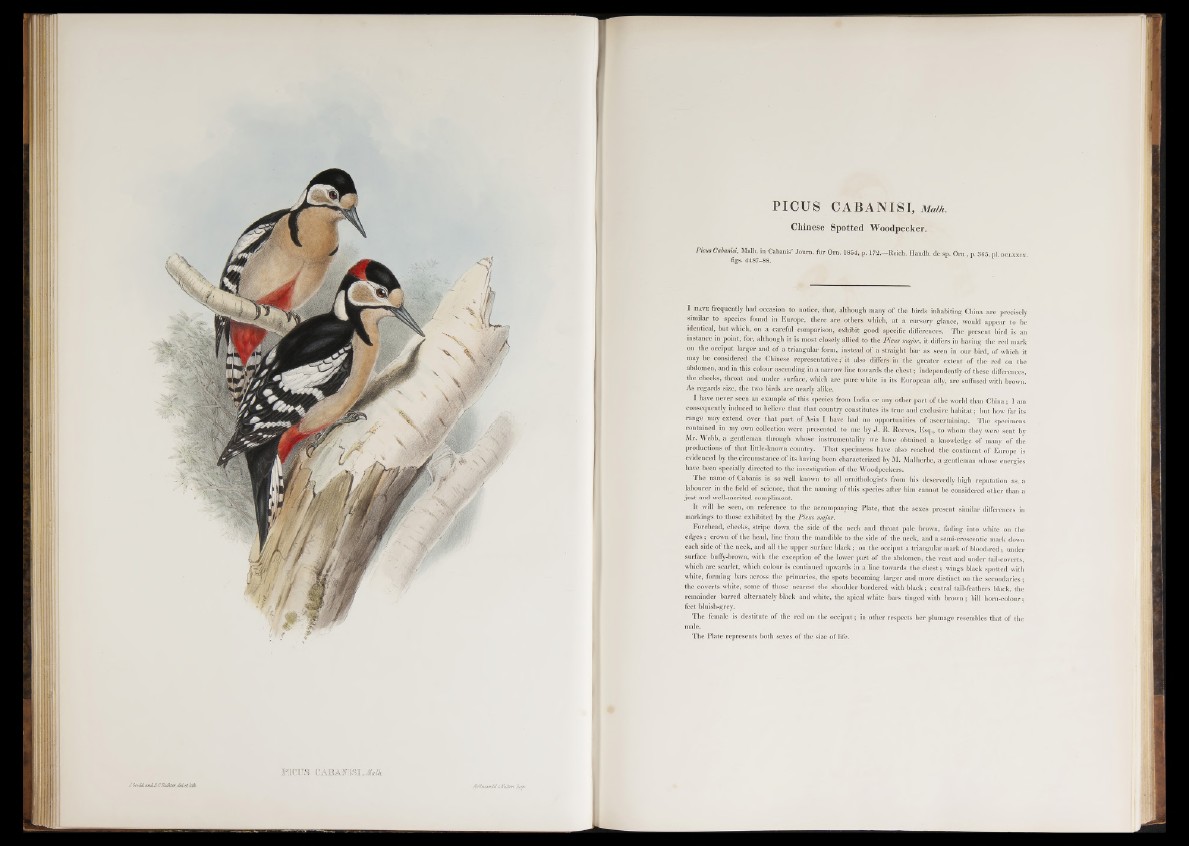
J.GouMcouLKCJUAter,dtietUA.
FICUS CABANISI, M a Jh .
Jßit/nvnukl Jr Hicßm. flap.
PICUS CABANI S I , Maih.
Chinese Spotted Woodpecker.
p icus Cabanisi, Malh. in Cabanis’ Joum. fdr Om. 1854, p. 172.— Reich. Handb. de sp. Ora., p. 365. pi. d c l x x ix
figs. 4487-88.
I h a v e frequently had occasion to notice, that, although many o f the birds inhabiting China are precisely
similar to species found in Europe, there are others which, at a cursory glance, would appear to be
identical, but which, on a careful comparison, exhibit good specific differences. The present bird is an
instance in point, for, although it is most closely allied to the Picus major, it differs in having the red mark
on the occiput larger and of a triangular form, instead of a straight bar as seen in our bird, of which it
may be considered the Chinese representative f it also differs in the greater extent of the red on the
abdomen, and in this colour ascending in a narrow line towards the chest; independently o f these differences,
the cheeks, throat and under surface, which are pure white in its European ally, are suffused with brown.
As regards size, the two birds are nearly alike.
I have never seen an example of this species from India or any other part of the world than China; I am
consequently induced to believe that that country constitutes its true and exclusive habitat; but how far its
range may extend over that part of Asia I have had no opportunities of ascertaining. The specimens
contained in my own collection were presented to me by J. R. Reeves, Esq., to whom they were sent by
Mr. Webb, a gentleman through whose instrumentality we have obtained a knowledge o f many of the
productions of that little-known country. That specimens have also reached the continent of Europe is
evidenced by the circumstance o f its having been characterized by M. Malherbe, a gentleman whose energies
have been specially directed to the investigation of the Woodpeckers.
The name of Cabanis is so well known to all ornithologists from his deservedly high reputation as. a
labourer in the field of science, that the naming o f this species after him cannot be considered other than a
just and well-merited compliment.
It will be seen, on reference to the accompanying Plate, that the sexes present similar differences in
markings to those exhibited by the Picus major.
Forehead, cheeks, stripe down the side o f the neck and throat pale brown, fading into white on the
edges; crown of the head, line from the mandible to the side o f the neck, and a semi-crescentic mark down
each side of the neck, and all the upper surface black; on the occiput a triangular mark of blood-red; under
surface bufly-brown, with the exception o f the lower part of the abdomen, the vent and under tail-coverts,
which are scarlet, which colour is continued upwards in a line towards the chest; wings black spotted with
white, forming bars across the primaries, the spots becoming larger and more distinct on the secondaries;
the coverts white, some of those nearest the shoulder bordered with black; central tail-feathers black, the
remainder barred alternately black and white, the apical white bars tinged with brown; bill horn-colour;
feet bluish-grey.
The female is destitute of the red on the occiput; in other respects her plumage resembles that of the
male.
The Plate represents both sexes of the size of life.